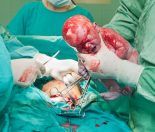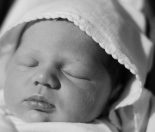Twins and triplets are increasingly common in New Zealand – to find out more about twin births and multiple births, read on.
Twins and other multiples
Non identical twins are far more common that identical twins.
Twin births would naturally occur in approximately 1 in every 100 pregnancies, but this rate has increased due to IVF in recent years. Triplets and other multiples, such as quads, quints etc are an extremely rare natural occurrence, with triplets only occurring naturally in 1 in 8,000 pregnancies!
There are now guidelines in many countries regarding the number of embryos that are inserted back into the mum’s womb during each cycle of IVF, so triplets are less common than a few years ago.
What are the implications for twin pregnancies?
Twin pregnancies carry greater risks than singleton pregnancies (one baby only). The chances of complications are heightened by the fact that there are 2 babies growing together. For example:
- the risk of pre eclampsia is higher
- the risk of haemorrhage in pregnancy is higher
- the risk of prematurity is higher
- the risk of the baby getting into a mal position is higher – a position that can reduce the chance of a normal birth
- the risk of the mother having a haemorrhage after the birth is also higher (losing more than 500mls of blood)
| Find the Right Pregnancy & Birth Book for You!Click here for the Most Popular International BestSellers | ||||
 |
 |
 |
||
What are the implications for twin births?
The position of Twin I is crucial to the plan for labour and birth. If the pregnancy has been complication-free (and most are) and Twin I is head down, or cephalic, then a normal birth will usually be planned between the woman, her whanau and her maternity professionals. (Most women having twins will be under the care of an obstetrician as well as a midwife.)
The position of Twin II is really irrelevant at this stage, as it is likely to change after the birth of Twin I.
If Twin I is breech (bottom first), or transverse (lying across the entrance to the womb) then a Caesarean will usually be planned for around 37-39 weeks, depending upon other factors, such as the growth of the twins and mother’s health. This is known as an elective Caesarean and it will be just the same as any other Caesarean, except of course two babies will be born, usually within a minute or two of each other. Do expect quite a few people at the birth, as there will be twice the number of staff potentially needed to care for 2 babies.
A normal birth of twins
Many women successfully give birth to twins vaginally with little intervention. The majority of women carrying a twin pregnancy will go into labour before the due date and would be encouraged to contact their midwife/doctor as soon as possible. Most twin births are in hospitals, due to the increased risk of complications, but occasionally women do choose to birth at home.
On arrival at hospital the mother will be checked over by her midwife and the well being of the babies will be monitored, usually by a cardiotocograph, or CTG. Both babies’ heart beats will be recorded simultaneously, to check that Twin I and Twin II are coping with the contractions. The first stage of labour will be much the same as any other labour, with the midwife ensuring that the labour is progressing normally, by feeling the babies through Mum’s abdomen and by doing vaginal examinations (with consent) to assess how the cervix opening in preparation for the birth. Often the mother’s mobility will be restricted by the continuous monitoring of the babies’ heart rates – this does not prevent the mother from adopting upright positions to make her comfortable and to help labour along.
Once the cervix is fully opened and the head of the first twin is low in the pelvis the pushing stage will begin. The length of time it takes to push for Twin I will depend upon the position of the baby, the size of the baby and whether or not the mother has given birth before.
After the birth of Twin I the baby will be with mum and dad and often the midwife will suggest that an early breastfeed is beneficial:
- To feed baby early is always great to establishing breastfeeding
- Breastfeeding causes the womb to contract, so helps with the birth of twin II.
The midwife or doctor will want to check the position of Twin II – this may be quite different to the position of the baby earlier in the labour, when the twins were competing for space! Either by feeling mum’s abdomen, or by doing a quick ultrasound scan, the position of baby will be determined. If the baby is head down, then great! Pushing will recommence and usually Twin II will be born within half an hour. Occasionally twin II is in an awkward position for birth and may need to be ‘manipulated’ or turned by the obstetrician, in order to achieve a safe vaginal birth. Meanwhile the maternity staff will keep a close eye and ear on the baby’s heart beat, as Twin II can be at risk of fetal distress at this time.
After the birth of Twin II the placenta will be delivered, most commonly using the injection, syntometrine, to ensure effective contractions of the womb, following what is often a long, hard labour. Usually the babies will be with their parents at this time. Staff will be at hand in case of any problems with the twins, but in most cases the babies will need a cuddle and a feed, just like any other new babies.
What pain relief will be available?
The same pain relief is available for twins as for any other labour. Often women are encouraged to have an epidural, due to the increased risk of complications during twin labours. For more information on epidural anaesthesia, please visit the link below.
What are the implications of multiple births?
Whilst many women have beautiful, normal births of twins, the chances of complications are increased when there are twins or more. It is practically unheard of women in the Western world to deliver triplets or other multiples vaginally – it would be considered too risky, even if the babies appeared to be in a good position prior to labour. In all cases the woman and her whanau would be advised that Caesarean section would be the safest alternative.
Will I need a Caesarean section?
Certainly the risk of Caesarean section is increased with twin births, but more than half of women give birth vaginally to twins.
There is always a small possibility that despite giving birth to Twin I vaginally, a Caesarean section could be necessary for Twin II – due to the position of the baby or fetal distress.
Mothers having a multiple birth of 3 or more will inevitably be advised to have a Caesarean section.
Will my babies be premature?
It is more likely that twins (and especially any other multiples) will be born prematurely. This may be due to:
- increased growth of the womb
- pre-eclampsia
- reduced growth of one or more babies.
What can I do to help my babies?
Just like any other mum to be it is vital that you care for yourself in pregnancy and in preparation for the birth:
- Rest as much as possible in pregnancy
- Exercise gently, even if you feel cumbersome towards the end of pregnancy (water is perfect, as the buoyancy will feel great)
- Eat well, ensure a balanced diet
- Keep an open mind around the birth – events may occur which are out of your control. The outcome will hopefully be two healthy new babies – enjoy!
- And get some sleep somehow!
Useful articles
To find out more about Normal Birth, visit our Kiwi Families article.
Click here to read more about epidural anaesthesia
Twin and multiple births have a higher risk of Caesarean section. Visit our Kiwi Families articles on Caesarean section to find out more.
Receive support from the NZ Multiple Birth Association .









Different hospitals and different Obstetricians have different viewpoints, even within NZ. For example, at Middlemore Hospital twin vaginal deliveries are relatively common. Whereas at North Shore Hospital twin C-sections are commonly performed, but also aren’t totally routine. Certainly the mothers’ preferences must by law be taken into account (she cannot be forced to consent to surgery) and it is the Obstetrician’s role to explain the risks and benefits of both options. Plus it depends on a multitude of other contributing factors, such as whether the twins are identical/fraternal/DCDA/MCDA/MCMA; plus their Lie (is the leading twin or both twins head-down); and… Read more »
What are the added risks involved with Identical Twins? NZ seems to push for Normal birth and only look at C section if Normal is out of the question… But forums from other countries are the opposite with the drs pushing for C section and only considering Normal birth if the mother really pushes for it.